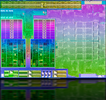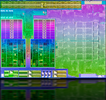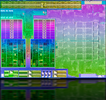AMD A8-4500M vs AMD A4-4300M vs AMD A4-4355M
AMD A8-4500M
► remove from comparison
The AMD A8-4500M is a mobile quad-core processor based on the Trinity architecture. Officially introduced in Q2 2012, it is the direct successor to the Llano A-series of APUs (Accelerated Processing Unit). The processing unit is manufactured in 32nm SOI and integrates a 1.9 GHz CPU (up to 2.8 GHz w/ Turbo Core) with a relatively fast Radeon HD 7640G GPU alongside a dual-channel memory controller, video de- and encoders and a northbridge.
The CPU cores are based on a reworked Bulldozer architecture, called Piledriver. Although marketed as a quad-core processor, the A8-4500M includes only two modules with four integer-cores and two floating-point cores total. As a result, the CPU is not a true quad-core processor.
When compared to previous Bulldozer cores, AMD has managed to improve upon the IPC (instructions per clock) performance of Trinity cores while allowing for higher clock frequencies. However, when compared to its Llano predecessor, the multithreaded performance of Trinity has only been slightly improved. The enhanced Turbo Core 3.0 feature functions well in speeding up single threaded performance, although it is still not on the same level as Intel’s Turbo Boost equivalent. Regardless, AMD has managed to include other features as well, such as the AVX extension (including FMA) and support for AES encryption.
In terms of raw general performance, the A8-4500M performs similar to the Llano-based A8-3500M. Single-threaded workloads can especially benefit from the new architecture and the updated Turbo Core functionality. If compared to Intels Core-i3-series, the A8-4500M offers less performance in most cases. Nonetheless, CPU performance from the AMD processor should be sufficient for all daily workloads like Office, Internet browsing and even light video editing or gaming.
The integrated DirectX 11-compatible Radeon HD 7640G offers only 256 shader cores of the Trinity chip (7660G: 384) and, thanks to Turbo Core, will operate anywhere between 497 to 686 MHz depending on the current application demand. On average, the performance of the HD 7640G GPU is comparable to a dedicated Radeon HD 7610M and is even faster than the HD Graphics 4000 as found in Intel’s Ivy Bridge.
The power consumption of the A8-4500M APU is rated at 35 Watt TDP and is therefore comparable to mid-range dual-core Ivy Bridge processors. Consequently, the A8-4500M is best suited for 14-inch notebooks or larger.
AMD A4-4300M
► remove from comparison
The AMD A4-4300M is a mobile dual-core processor based on the Trinity architecture. Officially introduced in 2012, it is the direct successor to the Llano A-series of APUs (Accelerated Processing Unit). The processing unit is manufactured in 32nm SOI and integrates a 2.5 GHz CPU (up to 3.0 GHz w/ Turbo Core) with a Radeon HD 7420G GPU alongside a dual-channel memory controller, video de- and encoders and a northbridge.
The CPU cores are based on a reworked Bulldozer architecture, called Piledriver. Although marketed as a dual-core processor, the A4-4300M includes only one module with two integer-cores and one floating-point core. As a result, the CPU is not a true dual-core processor.
When compared to previous Bulldozer cores, AMD has managed to improve upon the IPC (instructions per clock) performance of Trinity cores while allowing for higher clock frequencies. However, when compared to its Llano predecessor, the multithreaded performance of Trinity has only been slightly improved. The enhanced Turbo Core 3.0 feature functions well in speeding up single threaded performance, although it is still not on the same level as Intel’s Turbo Boost equivalent. Regardless, AMD has managed to include other features as well, such as the AVX extension (including FMA) and support for AES encryption.
In terms of raw general performance, the A4-4300M performs similar to the Llano-based A4-3310MX. Single-threaded workloads can especially benefit from the new architecture and the updated Turbo Core functionality. If compared to Intels Pentium-series, the A4-4300M offers less performance in most cases. Nonetheless, CPU performance from the AMD processor is sufficient for all daily workloads like Office and Internet browsing, but will reach its limits in more demanding applications.
The integrated DirectX 11-compatible Radeon HD 7420G offers probably only 192 shader cores of the Trinity chip (7660G: 384) and, thanks to Turbo Core, will operate anywhere between 470 to 640 MHz depending on the current application demand. On average, the performance of the HD 7420G GPU is somewhere between the Llano-based Radeon HD 6520G and the HD Graphics 4000 as found in Intel’s Ivy Bridge.
The power consumption of the A4-4300M APU is rated at 35 Watt TDP and is therefore comparable to dual-core Ivy Bridge processors. Consequently, the A4-4300M is best suited for 14-inch notebooks or larger.
AMD A4-4355M
► remove from comparison
The AMD A4-4355M is a mobile ultra-low-voltage (ULV) dual-core processor based on the Trinity architecture. Officially introduced in Q4 2012, it is the direct successor to the Llano A-series of APUs (Accelerated Processing Unit). The processing unit is manufactured in 32nm SOI and integrates a 1.9 GHz CPU (up to 2.4 GHz w/ Turbo Core) with a Radeon HD 7400G GPU alongside a dual-channel memory controller, video de- and encoders and a northbridge.
The CPU cores are based on a reworked Bulldozer architecture, called Piledriver. Although marketed as a dual-core processor, the A4-4355M includes only one module with two integer-cores and a floating-point core. As a result, the CPU is not a true dual-core processor.
When compared to previous Bulldozer cores, AMD has managed to improve upon the IPC (instructions per clock) performance of Trinity cores while allowing for higher clock frequencies. However, when compared to its Llano predecessor, the multithreaded performance of Trinity has only been slightly improved. The enhanced Turbo Core 3.0 feature functions well in speeding up single threaded performance, although it is still not on the same level as Intel’s Turbo Boost equivalent. Regardless, AMD has managed to include other features as well, such as the AVX extension (including FMA) and support for AES encryption.
In terms of raw general performance, the A4-4355M performs significantly faster than the E-Series (e.g. E2-1800) and competes with Intels Celeron and Pentium ULV processors. CPU performance from the AMD processor should be sufficient for all daily workloads like Office and Internet browsing, but will reach its limits in more demanding applications and multitasking.
The APU integrates a DirectX 11-compatible GPU called Radeon HD 7400G.
The power consumption of the A4-4355M APU is rated at 17 Watt TDP and is therefore comparable to Intels ULV-processors. Consequently, the A4-4355M is best suited for thin-and-light notebooks.
| Model | AMD A8-4500M | AMD A4-4300M | AMD A4-4355M | ||||||||||||||||||||||||||||||||||||||||||||||||||||||||||||||||||||||||||||||||||||||||||||||||||||||||||||||||||||||||
| Codename | Trinity | Trinity | Trinity | ||||||||||||||||||||||||||||||||||||||||||||||||||||||||||||||||||||||||||||||||||||||||||||||||||||||||||||||||||||||||
| Series | AMD AMD A-Series | AMD AMD A-Series | AMD AMD A-Series | ||||||||||||||||||||||||||||||||||||||||||||||||||||||||||||||||||||||||||||||||||||||||||||||||||||||||||||||||||||||||
| Series: AMD A-Series Trinity |
|
|
| ||||||||||||||||||||||||||||||||||||||||||||||||||||||||||||||||||||||||||||||||||||||||||||||||||||||||||||||||||||||||
| Clock | 1900 - 2800 MHz | 2500 - 3000 MHz | 1900 - 2400 MHz | ||||||||||||||||||||||||||||||||||||||||||||||||||||||||||||||||||||||||||||||||||||||||||||||||||||||||||||||||||||||||
| L2 Cache | 4 MB | 1 MB | 2 MB | ||||||||||||||||||||||||||||||||||||||||||||||||||||||||||||||||||||||||||||||||||||||||||||||||||||||||||||||||||||||||
| Cores / Threads | 4 / 4 | 2 | 2 | ||||||||||||||||||||||||||||||||||||||||||||||||||||||||||||||||||||||||||||||||||||||||||||||||||||||||||||||||||||||||
| TDP | 35 Watt | 35 Watt | 17 Watt | ||||||||||||||||||||||||||||||||||||||||||||||||||||||||||||||||||||||||||||||||||||||||||||||||||||||||||||||||||||||||
| Transistors | 1303 Million | 1303 Million | 1303 Million | ||||||||||||||||||||||||||||||||||||||||||||||||||||||||||||||||||||||||||||||||||||||||||||||||||||||||||||||||||||||||
| Technology | 32 nm | 32 nm | 32 nm | ||||||||||||||||||||||||||||||||||||||||||||||||||||||||||||||||||||||||||||||||||||||||||||||||||||||||||||||||||||||||
| Die Size | 246 mm2 | 246 mm2 | 246 mm2 | ||||||||||||||||||||||||||||||||||||||||||||||||||||||||||||||||||||||||||||||||||||||||||||||||||||||||||||||||||||||||
| Features | SSE (1, 2, 3, 3S, 4.1, 4.2, 4A), x86-64, AES, AVX, FMA | SSE (1, 2, 3, 3S, 4.1, 4.2, 4A), x86-64, AES, AVX, FMA | SSE (1, 2, 3, 3S, 4.1, 4.2, 4A), x86-64, AES, AVX, FMA | ||||||||||||||||||||||||||||||||||||||||||||||||||||||||||||||||||||||||||||||||||||||||||||||||||||||||||||||||||||||||
| iGPU | AMD Radeon HD 7640G (496 - 685 MHz) | AMD Radeon HD 7420G (480 - 655 MHz) | AMD Radeon HD 7400G (327 - 424 MHz) | ||||||||||||||||||||||||||||||||||||||||||||||||||||||||||||||||||||||||||||||||||||||||||||||||||||||||||||||||||||||||
| Architecture | x86 | x86 | x86 | ||||||||||||||||||||||||||||||||||||||||||||||||||||||||||||||||||||||||||||||||||||||||||||||||||||||||||||||||||||||||
| Announced |
Benchmarks
Average Benchmarks AMD A8-4500M → 100% n=20
Average Benchmarks AMD A4-4300M → 76% n=20
Average Benchmarks AMD A4-4355M → 64% n=20
* Smaller numbers mean a higher performance
1 This benchmark is not used for the average calculation












